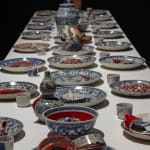 installation view
installation view
 installation view
installation view

Nguyễn Duy Mạnh
Phách Lạc (Lost Spirits) I, table no.1, 2018-2023
40 components (set for 20 seats), hand made and painted ceramic, fired in Bat Trang pottery village + 20 cups ⌀ 6 x 6 cm, printed pattern ceramic.
Details in an attached list of works.
Details in an attached list of works.
Variable dimensions, not including the display table.
Unique piece.
Unique piece.
© Nguyễn Duy Mạnh
Further images
‘Phách Lạc (Lost Spirits)’ is a bullet-pocked table-setting for six, a suite of ‘blue-ware’ style ceramic crockery (in Vietnamese known as the Chu Đậu style) viscerally flayed, like skin, revealing...
‘Phách Lạc (Lost Spirits)’ is a bullet-pocked table-setting for six, a suite of ‘blue-ware’ style ceramic crockery (in Vietnamese known as the Chu Đậu style) viscerally flayed, like skin, revealing bleeding incisions of deep red. On one plate the auspicious dragon has become a vulgar noodle dish; the phoenix (the incarnation of a woman in Vietnam) is served as a wrinkled skin; a classic vase is presented as bone marrow; while the traditional bánh cuốn (Vietnamese rolled crepe) is made from the skinned surface of the actual plate. According to Vietnamese belief, the human soul is composed of two entities, hồn (spirit) and phách (spirit vessel) – the latter upon death always falling to earth. To Nguyễn Duy Mạnh, this ceramic tableware represents the phách – what he terms the ‘spirit envelopes’ – of the lost. They remain on earth in a gradual state of decay. Tellingly, the cultural inferences of the design and painted motif, on these phách, not only recall the symbols of Vietnamese traditions, they also infer the complex socio-political history of Vietnam and its vassal/colonial/Cold War relationships with China/France/USA (ie. such ceramic was first brought to Vietnam via trade with China; such consequent locally produced ceramic becoming a key export under French occupation; whilst the Communist union of a ‘Vietnam’ following the ‘American War’, saw the ‘fixed’ (ideological) interpretation of much Vietnamese tradition). Duy Mạnh bemoans the fact that much of this Chu Đậu style has also countless fraudulent copies circulating auctions today, which has significantly impacted Vietnam’s international art market and its reputation. Nguyễn Duy Mạnh ultimately ponders, what heritage does Vietnam claim and respect? Is contemporary Vietnamese society aware of the impact of their essentializing, tokenizing, commodification of their own cultural memory and customs?
Exhibitions
2025 ...MassMOCA2024 Becoming Alice: In The Metal Tunnel, curated by Lê Thuận Uyên, The Outpost Art Organization, Hanoi, Vietnam



